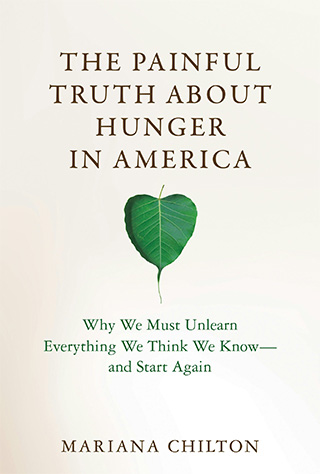The Cruel Reality of Public Assistance Programs

I was in my office fiddling with the giant scissors we bought to cut the big red ribbon for the next day’s grand opening.
Ring! Ring!
Slinging the scissors up over my shoulder, I looked at the caller ID. It was the chef manager of the EAT Café.
Hey, uh . . .
The toilet in the basement
burst.
There’s sewage running all over the basement floor.
We need a plumber,
ASAP.
It stinks!
It was the end of our workday, and we were finalizing plans for the next morning’s grand opening. For our team, opening the EAT Café signified the culmination of decades of painstaking work on hunger. After years of careful study and research, successful programming, and deliberate and well-thought-out political action, we were going to try something new. It felt as if our team was at the precipice of a great achievement.

The name EAT Café stands for Everyone At the Table. Regardless of people’s ability to pay, we welcomed everyone to join in and enjoy a three-course meal served directly to their table just like they do at a full-service restaurant.
This was the vision: People who do not have enough money can enjoy a meal made from scratch served with care to their table. Wealthy people would come to the EAT Café because not only was the food delicious but they would feel happy and satisfied supporting the mission as well. The EAT Café was based on the idea that people who can afford to pay would pay extra money to supplement the cost of meals for those who could not afford to pay. Everyone orders from the same menu and shares the same energy in this joyous, colorful, and communal place without privilege or marginalization, without separation of rich and poor, Black people and white people, immigrant and citizen, professor and sex worker. Everyone is welcome, equal, celebrated, and nourished.
After two and a half years of operating the EAT Café from 2016 to 2019, having tried various forms of advertising, changing the menu, changing the prices, and improving customer service, the café was unable to bring in enough money to break even. Our dreams of transforming it into a worker-owned cooperative were fading.
People tried to console us. They said, “Most new restaurants close within the first six months” and “many don’t make it past a year.” One reason we had difficulty getting stable was that we funded the café through foundation grants that had to be administered through the university. No university should administer a restaurant, as human resources takes three months to hire people and almost a year to let someone go. That timing does not work in a restaurant. Another reason was that, unlike most restaurants, we paid well. Full-time staff received health benefits. Restaurant industry partners in Philadelphia warned us that we would never be financially viable if we paid living wages and provided sick leave.
Still today, corporations use tipped wages to continue the plunder that spans hundreds of years.
We also refused to pay tipped minimum wage ($2.25 per hour), nor did the café accept tips. Tipped wages come straight out of slavery. Immediately after Emancipation in 1865, many southern states passed “Black codes” as a continuation of enslavement. If approached and questioned by white people, Black people had to prove they were working or they would be criminalized, thrown in prison, and then forced to work for free. Oftentimes, Black adults were forced by white employers to sign yearly contracts. Many white employers refused to pay people who had been enslaved. To survive, Black people in the South had to find the most immediate job available — even if it did not pay — to stay out of prison. Employers frequently would not pay a Black person outright, and Black people had to depend on customer tips, an unpredictable paltry wage. Still today, corporations use tipped wages to continue the plunder that spans hundreds of years. The U.S. government allows it. But at the EAT Café, we meant to break that chain.
After a time, the original philanthropic groups that helped us get started became tired of footing the bill. So they stopped funding us. We tried to get other foundations interested in the café, but they did not want to fund it because it wasn’t “new” enough. Finally, well-paying customers stopped paying well or stopped coming altogether. We became desperate and highly dependent on a generous anonymous donor. We knew that funding model was not sustainable. All along, those who enjoyed eating for free or low cost really loved the EAT Café and invited more friends. It was not empty; we were just broke. We hated to close the EAT Café in April 2019. We also didn’t want to leave the café empty while we figured out a way to pivot.
Enter summer meals for schoolchildren.
DON’T FEED ADULTS
The Summer Food Service Program is a federally funded, state-administered effort that reimburses organizations that serve free meals and snacks to children and teens in low-income areas when school is not in session. It launched in 1968 as an extension of the school breakfast and lunch program. While families can rely on breakfast and lunch for their children during the school year, they struggle during summer — the season when food insecurity spikes because the kids are not receiving meals at school. In consideration of this trend, the federal government provides per-child reimbursement for breakfast and/or lunch at community centers, schools, bible camps, and other locales with educational or enrichment activities.
Until 2020, only 16 percent of the children who were eligible received summer meals. Even then, they did not receive them every day nor every summer week. Summer meals distribution depends on transportation, availability, and summer programming, the will of political leaders and nonprofits, and the weather. Some communities get meals delivered on school buses or by vans that become a pop-up café. Programs in other areas such as in the Anacostia neighborhood of Washington, DC, could reach up to 40 percent of children because they served meals at the public libraries.
In addition to the requirement to provide enrichment activities, these were the rules.
First, all children must be counted every day. They must be counted on paper (not by computer). Otherwise, the “provider” (those who make and deliver the food) will not receive reimbursement for supplying that child’s meal. For organizations with scarce funding, that can make a big difference.
Second, all meals must be eaten on-site. No one can take home leftovers unless it is the end of the meal service time.
Finally, adults are not allowed to eat.
Let that sink in.
Nutritional Development Services is a primary sponsor in Philadelphia. It was delighted to help us set up a summer meals site at the EAT Café. We were so grateful, as it provided our team with free and enthusiastic training. But then its staff sent us flyers that we were required to place around the EAT Café as a condition of serving meals. The flyers consisted of “dos” and “don’ts.”
Here is one of the “don’ts,” typed verbatim:
DON’T FEED ADULTS
Don’t allow adults to take items from the Share Table. This includes parents, volunteers, or any adults from the community. I’m sure this reminds you of similar signs in zoos and parks: “DON’T FEED DUCKS. DON’T FEED ELEPHANTS.” During summer meals service, adults are clearly not part of the human family, and thus not worthy of a meal.
I emailed the coordinator at Nutritional Development Services suggesting the language was hostile. They explained in their return email that “strong language was needed” because the agency hears many reports of adults “hovering for a meal or leftovers.” I disagreed with the tactic and implored the staff to change their signs. After a few weeks, they changed their poster to say, “DON’T LET THESE ITEMS GO TO WASTE.”
Every summer, those in the antihunger community hear about programs that refuse to let parents share meals or take food home. According to New Mexico’s chief of the Family Nutrition Bureau, Reagan Smetak, who provided testimony to the National Commission on Hunger in 2014, parents would eat parts of their child’s on-site summer meal, and grandparents who accompanied their children would roll food up in a napkin and put it into their purses for later. In 2018, a Colorado summer meal program made a posting in its locale. The sign stated, “Adults MAY NOT eat off of a Child’s Plate!” The flyer had a cartoon of people around a table, with three children at the table and two adults standing around. The adults each had a circle around their head with a red line drawn diagonally through it, as if to cross them out.
While nonprofits and Indigenous communities scramble to find ways to feed kids in the summer (and some even try to be creative in finding ways to make sure adults don’t eat), the USDA already had a proven solution to summer hunger. In 2014, it began a pilot in three communities by providing $30 per child per summer month to families receiving SNAP or WIC. The program, called Summer Electronic Benefits Transfer (EBT), provided money directly to caregivers. Evaluations of the program found that compared to those who did not receive Summer EBT, those who did reported a 30 percent reduction in very low food security. That is a profoundly positive impact.
The USDA, researchers, and advocates have known about the success of this program for years. This became important during the COVID-19 pandemic. With children suddenly out of school, thousands of people provided community meal sites as well as grab-and-go breakfasts and lunches, and the USDA finally made it possible for each state to create Pandemic EBT. Most states opted to continue providing Pandemic EBT through the summer the following two years. Additionally, the USDA offered a federal waiver to reduce reporting requirements for each child to support physical distancing.
Do you wonder why, before the pandemic, children in the United States had no opportunity to access Summer EBT, even though the federal government had evidence it reduced food insecurity by 30 percent?
Intentional design.
Herein lies the problem not solely with summer meals but instead with all public assistance programs devised in the United States. They create a false division between parent and child; they separate the wealthy from the people who are low income, the “deserving” from the “undeserving.” Summer meals are for kids only, even if their parents are close by and hungry. Separating the wealthy from people with little money means that eligibility criteria is dependent on proving one’s income is below a certain percentage of the federal poverty line. This last part of eligibility is ostensibly to ensure that people who make a certain amount of money over a low threshold, or, in some states, if they had a felony, should not get support that they may desperately need. This ongoing separation of groups and families from each other becomes a way to target destitution.
THE UNSETTLING TRUTH
As they try to understand the policy-related dynamics of public assistance, most researchers adhere to what is on paper or in public assistance participation data. But how public assistance programs are experienced by families and in people’s bodies is the most important wisdom there is when it comes to understanding public assistance. Public assistance programs can help somewhat. Yet they can simultaneously cause harm.
I was not always clear on how public assistance programs can cause harm. The epidemiology and economics research on these programs shows that they can help people be healthier, stay safe, or stabilize otherwise turbulent lives. SNAP is associated with reduced child hospitalization. WIC is associated with reductions in stress, preterm birth, and underweight issues. Housing subsidies protected children from being underweight, and energy assistance promoted children’s development. The evidence for the positive benefits of strong public assistance programs is irrefutable.
When I started Witnesses to Hunger and invited members to use their photos as their voice to advocate on their own behalf, they asked me for examples of how I advocated on poverty.
I explained, “I say things like ‘Food stamps are good medicine, but the dosage is not enough.’ I say, ‘We need to protect SNAP.’”
Some members responded with revulsion.
No, Mariana.
That’s terrible!
I don’t want to be on food stamps for the rest of my life.
I want to get off food stamps
forever.
I want out
of the system.
Shirley is a tall and fashionable Black woman who loved going to hear live jazz with friends. In addition to taking many photos of her smiley children whom she adored and of nature scenes — bushes, rabbits, trees, rainbows over the nearby row homes, and ominous clouds during thunderstorms — she took one of the most iconic photos of the exhibit. It’s one she wanted to highlight despite it being devoid of children and nature; it was a photo of a simple chain with a backdrop of drywall.
I took this picture of a chain
to show you that
welfare is like a chain.
It’s meant to keep you down.
She was not alone. Consider the insights from Jewell. When she and I talked about how she experienced Medicaid benefits, she described it this way:
Medicaid will cover my health benefits only so much.
It’s like they give you just enough,
just enough to hang yourself.
If I had not listened to members of Witnesses and absorbed their points of view, I might still be trying to advocate for public assistance programs without thought, care, or nuance.
As with everything I learned from members of Witnesses, the truth is unsettling.
IT’S NOT A NET, IT’S A CHAIN
Some people refer to public assistance — which includes many programs such as housing assistance, energy assistance, SNAP, Medicaid, and TANF — as the safety net. But this term is inadequate; it is not woven together like a net that catches people as they fall toward deprivation. One staff member from my team prefers to call it the safety floor because when you are in that system, you are close to rock bottom; there is nothing safe about it. It is inadequate at best. At worst, it is a basement floor that leaks sewage, equipped with chains to imprison women and children.
To participate in most public assistance programs, one needs to demonstrate “need” or eligibility. This is mostly achieved through proving a person has a low enough income in comparison to the criterion of the federal poverty line. This is a level of income that indicates whether a person is eligible for support. It is based solely on the supposed cost of food, income, and family size. The poverty line is calculated from an outdated back-of-the-napkin measure based on the cost of food from the 1960s. At that time, the average family spent one-third of its income on food. But over the years, the cost of transportation, housing, and childcare became much more important as both parents entered the workforce. These days, food is a much smaller share of family budgets compared to 50 years ago. Yet the federal government refuses to change its multiplier to match the times.
Rather than multiplying the cost of food by 3 to get the federal poverty level, the multiplier should be 7.8.
Consider that in 2022, the federal poverty level for a family of two was $17,420. Multiplying the cost of food by 7.8 would calculate the federal poverty level to $45,292 if the federal government based its calculations on reality. Millions more people would be eligible to receive support, and food insecurity would be considerably lower because more people would get necessary assistance. But the U.S. government, stuck deep in the past, insists on using the inaccurate calculation that undermines people and keeps them impoverished.
The poverty line is calculated from an outdated back-of-the-napkin measure based on the cost of food from the 1960s.
Food is a single basic need among many competing needs. One single cost is not fully relevant, nor is it adequate to calculate a family’s cost of living, which should be based on local housing costs along with a combination of multiple basic needs including a cell phone and ample time for rest. Administrators know the federal poverty measure is too low, so they established a variety of thresholds for program eligibility. To be eligible for SNAP, the federal threshold is 130 percent of the federal poverty line (but states can raise the threshold); for WIC, it is 185 percent of the poverty line. Unlike SNAP and WIC, which acknowledge and support families whose incomes are higher than the federal poverty line, eligibility for TANF demands that they must have income that is less than half the amount of the federal poverty line. This punishing eligibility rule has not changed since 1996.
According to Shirley, once you get TANF “benefits,” you regret it the same day. County assistance office caseworkers will put you through the wringer when you go to an office to apply for public assistance. In his book “Street Level Bureaucracy,” Michael Lipksy describes how frontline caseworkers often take matters into their own hands to discern whether a person is eligible for assistance. They are frontline arbiters of stigma against people with low incomes. Overworked at their jobs, they also bring in their own philosophies of what constitutes appropriate behavior.
Interactions at the county assistance offices are described as stressful and humiliating. They are an assault on people’s time too. Many participants have complained that caseworkers are incompetent and mean.
Public assistance program participants are required to provide documentation justifying how they use benefits and demonstrating their efforts to find work. Collecting and presenting that evidence can be a barrier, forcing some people off the programs that were helping them in the first place.
Pennsylvania caregivers who use TANF assistance to purchase a weekly public transportation pass must prove they did so by providing a paper photocopy of a paper receipt. If they do not have access to a photocopy machine, they must go to a copy store and pay for the photocopy. That receipt must be personally brought to the office or sent by fax to a county assistance office staff person. This fax, too, costs money. It is not clear if the person at the county assistance office meant to document and maintain evidence of the receipt ever finds it or enters the receipt into the data systems. In response, people hoard their receipts deep in their purses as if they are gold because they know they will be called on to prove the fax was sent, the purchase was made, the place was visited, and pennies were spent.
To receive TANF benefits in Pennsylvania, most parents must prove they are looking for work by documenting every hour of their search. They are required to submit a form that describes with whom they spoke, the number they called, and the outcome. That record must then be scanned and entered into a database by a county assistance staff person every week. If a person does not do this — or if there is an error by the staff person — the state may, yet again, send them a bill in ALL CAPITAL LETTERS saying they owe the state money. They will then take those dollars out of the next month’s grant. Or the caregiver might get their TANF benefits cut off, potentially leaving them and their kids hungry, unable to pay rent, or, worse, homeless.
If one fails to comply or cannot provide evidence of “work activity,” they are “terminated” or “termed.” Yes, I’ve seen it with my own eyes. That is the language used in the database and in indelible ink on yellow Post-it notes stuck to state-owned file cabinets.
Systemic discrimination is built into TANF’s structure. Welfare offices push recipients into low-wage jobs with unpredictable hours and no health benefits or sick leave. This happens because federal government mandates require that a certain number of people receiving TANF must enter the formal workforce every month. Contractors risk losing funding if they fail to place people in jobs — any job regardless of pay or quality — or force them out of TANF altogether so they do not detract from the ever-important work participation rate. If TANF beneficiaries cannot find a job within about 12 weeks, they must do unpaid “community service” for 20 hours a week to keep receiving their meager financial grant.
BIPARTISAN KNOCKOUT
Republican leaders who want to dismantle the safety net for people living in poverty would be pleased to hear these expressions of disdain for the programs. Democrats, on the other hand, tense up at the idea and say, “It’s true the programs don’t work well enough. But if you bring these problems into the open, all you’re doing is giving Republicans more ideas for getting rid of the programs altogether.” It is as if the Democrats, think tanks, and advocacy organizations hold up SNAP and summer meals like shiny armor to protect “the vulnerable.” They do so in public. But behind closed doors, they complain about their inadequacy.
During the Obama administration, in 2013, after Congress cut the SNAP program by over 5 billion dollars in favor of adding six cents per meal to the school lunch program to improve the quality, Congress threw a conciliatory crumb to those of us who balked at cutting SNAP in favor of minuscule improvements to school meals. It created a National Commission on Hunger. One million dollars was designated to establish a “bi-partisan commission to advise Congress and the Secretary of the USDA on how to address hunger in America.” Five members were nominated from the House of Representatives and five from the U.S. Senate with an even split between nominations from legislators of both parties.
When I was selected and then chosen to be the cochair, I had no idea of the headaches ahead.
From the start, the commission was doomed. According to the legislative language, the recommendations the commission could consider had to be made using “existing programs.” The existing programs we have in the United States are inadequate at best, and death dealing at worst. Yet we were restricted to existing programs — the same programs that sometimes created more problems.
With the contracted help of the Research Triangle Institute (RTI), the commission was able to travel to several states to make site visits and hold hearings. With 15 months of targeted research and support from RTI, we held eight formal hearings with over 200 testimony submissions to contribute to the unanimous bipartisan report with 30 recommendations. In the report “Freedom from Hunger: An Achievable Goal for the United States,” we proposed ways to improve SNAP and other nutrition programs. All the commissioners agreed: The existing public assistance programs needed overhauls. SNAP and WIC, however, got a positive nod from everyone, though we had many recommendations for improvement. For transformative change, we recommended the development of a national plan to end hunger. It was a challenge to accommodate disparate beliefs, politics, and expertise. But we managed to do so by staying focused on families, veterans, people with disabilities, and immigrants.
To improve the systems in a way that made sense would be almost impossible given the current mechanisms for program funding. Medicaid is funded through the Department of Health and Human Services, and states must match half the funding. SNAP is an entitlement program funded through the USDA, and TANF is funded through the Agency for Children and Families in the Department of Health and Human Services and has strict work requirements. People who work at these agencies are territorial about their funds as they fight to receive them from Congress annually or every five to six years. Additionally, because of legal requirements for releasing funds to states, federal law disallows funding from one program to be mixed with another.
This inability of our systems to truly help families in crisis was the fodder that Congressman Paul Ryan and House members were using to rationalize the dismantling of SNAP. Elected Republicans sought to turn SNAP into a “block grant” to provide more “flexibility.” This may sound reasonable on the surface. But this would have also cut $40 billion from SNAP, thereby dismantling the SNAP program and eliminating its entitlement structure. As an entitlement, everyone who is eligible has the right to receive the benefit. But without that entitlement, even if a person is eligible, they may not be able to receive support as it might depend on funds available or some other behavioral barrier that a state may want to put into place. In doing so, SNAP would run the risk of becoming an atrophied program like TANF that no longer responds to national economic downturns and financial crises among families. Several of us knew that the loss of entitlements would inevitably create more trouble.
We understood that, in politics, there is no room for subtlety, nuance, and grace.
Several commissioners felt pressure from legislative staffers, politicians, and advocates on the Left and Right to include specific recommendations with precise words for how to make recommendations. The language Republicans used to justify block granting SNAP included terms such as merging funding streams or program flexibility. They were naming the “shit” and calling in their own cleanup crew without drawing attention to where the shit came from — low wages, poor infrastructure, racism, discrimination, and social violence. Democratic lawmakers were back on their heels trying to defend the programs as they are, desperate to keep the crumbs for people who are struggling. Democratic agency heads were instead working quietly to find work-arounds to braid and merge funding streams. But they offered no new language to the commissioners and refused to give credence to the fact that public assistance programs were a scattershot, poorly informed effort to assist people.
Here’s the conundrum: How could we stay true to what we knew was right to help people get more supports without triggering the evisceration of SNAP (which would create more hunger)? Of course, those with Republican leanings were not as concerned the language was going to trigger support for dismantling SNAP’s entitlement status. They said they saw no harm in using the term flexibility. On the other hand, those who lived through the travesty of welfare reform and leaned Democrat were concerned the Republican Party would have another reason to dismantle SNAP. Without careful language, some of us thought all the building blocks of SNAP could be broken up through block granting. We understood that, in politics, there is no room for subtlety, nuance, and grace.
As we were finalizing the report, the presidential campaigns were heating up. People were taking Donald Trump seriously — including some members of the Hunger Commission. Others on the commission were edging toward Bernie Sanders. Our alignment was fraying, and we were losing each other’s trust. Everyone was on edge.
Each word carefully crafted, we managed to hold our consensus together and deliver the written report to every member of Congress along with the secretary of the USDA, Tom Vilsak, and Food and Nutrition Service undersecretary Kevin Concannon. The report was an example of how hunger could be addressed through bipartisan fashion.
But it became clear that other members of Congress and the USDA were mostly interested in squashing the report to minimize any potential news coverage, especially about our recommendations to increase the SNAP allotment, incentivize the purchase of fruits and vegetables, and restrict the purchase of sugar-sweetened beverages. At the end of our work, no member of Congress publicly supported the recommendations with any fervor. We had reached the end of the commission’s tenure. With no funding left, and without USDA and congressional support, we could do little to drum up media interest. The USDA, which was entrusted with overseeing the contracting process, ensured that all the money was spent out and any more staff time would be stopped on cue, on January 1, 2016. Our press release was set for a few days afterward on January 4, 2016.
Just to dig in the message that our endeavor was useless, the USDA decided to house the report, testimonies, and commission minutes and notes on a time-honored government website called the “cybercemetery.”
The report was dead on arrival.
It felt like getting hit from multiple directions. We dodged left, then right, then left, then over the unbelieving trolls of the think tanks and national organizations, and delivered the report to its own tombstone.
I was knocked out by the experience.
Concussed.
Such a star-spangled clash makes you want to reconsider everything. Our political systems are clearly not meant to help people living in poverty. Policymakers and those with some say in the matter can be so dysfunctional as to knock you out cold.
Mariana Chilton is Professor of Health Management and Policy at Dornsife School of Public Health at Drexel University. She founded the Center for Hunger-Free Communities, where she launched Witnesses to Hunger, a movement to increase women’s participation in the national dialogue on hunger and poverty, and the Building Wealth and Health Network to promote healing and economic security. She has testified on solutions to hunger before the U.S. Senate and U.S. House of Representatives. Chilton is the author of “The Painful Truth about Hunger in America,” from which this article is adapted.



